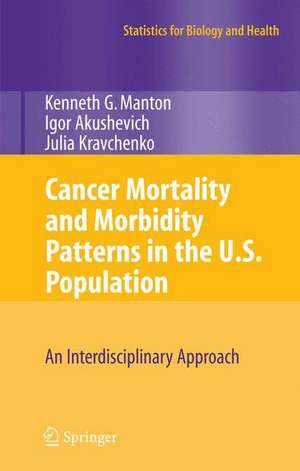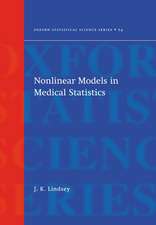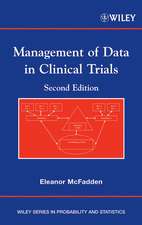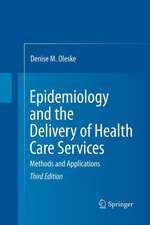Cancer Mortality and Morbidity Patterns in the U.S. Population: An Interdisciplinary Approach: Statistics for Biology and Health
Autor K.G. Manton, Igor Akushevich, Julia Kravchenkoen Limba Engleză Hardback – 18 dec 2008
| Toate formatele și edițiile | Preț | Express |
|---|---|---|
| Paperback (1) | 705.51 lei 6-8 săpt. | |
| Springer – 29 noi 2010 | 705.51 lei 6-8 săpt. | |
| Hardback (1) | 653.46 lei 6-8 săpt. | |
| Springer – 18 dec 2008 | 653.46 lei 6-8 săpt. |
Din seria Statistics for Biology and Health
- 20%
 Preț: 633.23 lei
Preț: 633.23 lei - 17%
 Preț: 352.01 lei
Preț: 352.01 lei - 20%
 Preț: 776.71 lei
Preț: 776.71 lei - 20%
 Preț: 1376.32 lei
Preț: 1376.32 lei - 18%
 Preț: 1394.84 lei
Preț: 1394.84 lei - 18%
 Preț: 883.59 lei
Preț: 883.59 lei - 5%
 Preț: 843.91 lei
Preț: 843.91 lei -
 Preț: 397.16 lei
Preț: 397.16 lei - 20%
 Preț: 1002.67 lei
Preț: 1002.67 lei - 18%
 Preț: 1395.32 lei
Preț: 1395.32 lei - 5%
 Preț: 1102.10 lei
Preț: 1102.10 lei - 5%
 Preț: 874.83 lei
Preț: 874.83 lei - 15%
 Preț: 657.39 lei
Preț: 657.39 lei - 18%
 Preț: 960.93 lei
Preț: 960.93 lei - 15%
 Preț: 585.90 lei
Preț: 585.90 lei - 5%
 Preț: 852.69 lei
Preț: 852.69 lei - 18%
 Preț: 903.62 lei
Preț: 903.62 lei - 5%
 Preț: 721.40 lei
Preț: 721.40 lei - 18%
 Preț: 2114.90 lei
Preț: 2114.90 lei - 18%
 Preț: 1108.99 lei
Preț: 1108.99 lei - 5%
 Preț: 821.39 lei
Preț: 821.39 lei - 5%
 Preț: 849.02 lei
Preț: 849.02 lei - 15%
 Preț: 653.14 lei
Preț: 653.14 lei - 18%
 Preț: 958.56 lei
Preț: 958.56 lei - 5%
 Preț: 722.69 lei
Preț: 722.69 lei - 18%
 Preț: 728.74 lei
Preț: 728.74 lei - 18%
 Preț: 943.22 lei
Preț: 943.22 lei - 5%
 Preț: 1092.43 lei
Preț: 1092.43 lei - 15%
 Preț: 594.21 lei
Preț: 594.21 lei - 5%
 Preț: 377.87 lei
Preț: 377.87 lei - 18%
 Preț: 1124.60 lei
Preț: 1124.60 lei - 18%
 Preț: 1220.12 lei
Preț: 1220.12 lei - 15%
 Preț: 632.98 lei
Preț: 632.98 lei - 18%
 Preț: 1394.84 lei
Preț: 1394.84 lei -
 Preț: 389.11 lei
Preț: 389.11 lei - 18%
 Preț: 959.98 lei
Preț: 959.98 lei
Preț: 653.46 lei
Preț vechi: 768.78 lei
-15% Nou
Puncte Express: 980
Preț estimativ în valută:
125.04€ • 130.90$ • 103.46£
125.04€ • 130.90$ • 103.46£
Carte tipărită la comandă
Livrare economică 05-19 aprilie
Preluare comenzi: 021 569.72.76
Specificații
ISBN-13: 9780387781921
ISBN-10: 0387781927
Pagini: 455
Ilustrații: XV, 455 p.
Dimensiuni: 155 x 235 x 25 mm
Greutate: 0.78 kg
Ediția:2009
Editura: Springer
Colecția Springer
Seria Statistics for Biology and Health
Locul publicării:New York, NY, United States
ISBN-10: 0387781927
Pagini: 455
Ilustrații: XV, 455 p.
Dimensiuni: 155 x 235 x 25 mm
Greutate: 0.78 kg
Ediția:2009
Editura: Springer
Colecția Springer
Seria Statistics for Biology and Health
Locul publicării:New York, NY, United States
Public țintă
Professional/practitionerCuprins
Cancer Contra Human: Cohabitation with Casualties?.- Cancer Modeling: How Far Can We Go?.- Cancer Risk Factors.- Standard and Innovative Statistical Methods for Empirically Analyzing Cancer Morbidity and Mortality.- Stochastic Methods of Analysis.- U.S. Cancer Morbidity and Mortality Trends.- U.S. Cancer Morbidity: Modeling Age-Patterns of Cancer Histotypes.- Risk Factors Intervention.- Cancer Prevention.
Recenzii
“The description and modeling of cancer mortality and morbidity deserve this important book. Several facets of the epidemiology of cancer are explored and documented. After a general assessment of the presence of cancer in the U.S. population …the heart of the book focuses on the methods for analyzing cancer, notably in age, time, “race,” and space. …There is a useful glossary of medical and statistical terms. …This book is essential not only to modelers of cancer mortality and morbidity, but it also serves as a good entry to anyone interested in classical tools of demographic epidemiology.” (Mathematical Population Studies, 17:65-66, 2010)
“The title is no lie: this is an interdisciplinary book from cover to cover. Its aim is to provide a broad education to a wide-ranging audience…on some of the tools used in cancer studies and some of those studies’ results. The authors have different areas of expertise and have worked to make sure that the book continually reflects all relevant disciplines. There are chapters that are primarily about the tools (mathematical and statistical models, both on a cellular and on a population level) and those that are primarily about the results (e.g., known risk factors, observed trends, and prevention strategies), but both types of chapters contain something from the other areas. Furthermore, these chapter s are intermingled, rather that segregated into two parts, emphasizing to me that the tools and the results are both just parts of the whole. Chapters where models are described do not shy away from using equations, including vector notation, to present the models, but the mathematical details of their derivation and analysis are appropriately omitted. Numerous plots, figures, and tables show results of analyses, and interpretations are given that are medical in nature but again not excessively technical. A 40-page glossary at the end defines both mathematical and medical terms in arelatively plain language. I believe that this book would be useful as an introduction to cancer studies for many people with expertise in one but not all relevant areas. It also serves as a summary of what is known about cancer so far…” (Biometrics, Summer 2009, 65, 1001)
“The title is no lie: this is an interdisciplinary book from cover to cover. Its aim is to provide a broad education to a wide-ranging audience…on some of the tools used in cancer studies and some of those studies’ results. The authors have different areas of expertise and have worked to make sure that the book continually reflects all relevant disciplines. There are chapters that are primarily about the tools (mathematical and statistical models, both on a cellular and on a population level) and those that are primarily about the results (e.g., known risk factors, observed trends, and prevention strategies), but both types of chapters contain something from the other areas. Furthermore, these chapter s are intermingled, rather that segregated into two parts, emphasizing to me that the tools and the results are both just parts of the whole. Chapters where models are described do not shy away from using equations, including vector notation, to present the models, but the mathematical details of their derivation and analysis are appropriately omitted. Numerous plots, figures, and tables show results of analyses, and interpretations are given that are medical in nature but again not excessively technical. A 40-page glossary at the end defines both mathematical and medical terms in arelatively plain language. I believe that this book would be useful as an introduction to cancer studies for many people with expertise in one but not all relevant areas. It also serves as a summary of what is known about cancer so far…” (Biometrics, Summer 2009, 65, 1001)
Textul de pe ultima copertă
This book is the first of its kind to describe interdisciplinary approaches to biomedical studies. It views analyses of biomedical data sets, such as cancer morbidity and mortality, from a different and richer than classic epidemiological perspective by using mathematical modeling methods, including ones providing insights into probable mechanisms of human carcinogenesis.
The book will be useful for many specialists, e.g., epidemiologists, oncologists, medical researchers, biologists, public health and environmental specialists, and specialists in mathematical modeling. Medical, biology and math undergraduates and postgraduates, as well as basic and applied researchers attempting to extend their studies in collaboration with other specialists in interdisciplinary teams, will find practical information here. Biomedical specialists could be interested in historical aspects of cancer treatment and prevention, mechanisms of carcinogenesis, cancer risk factors, cancer mortality and morbidity trends in the U.S. over a more than 50-year period, as well as specific features of cancer histotypes, and recent approaches to cancer prevention. Readers interested in analytic aspects can find information on existing and innovative approaches used in interdisciplinary studies such as stochastic process models, microsimulation of interventions, and empirical Bayes approaches.
This book was written by authors with different backgrounds who teamed in an interdisciplinary group. Kenneth G. Manton, Ph.D. (Demography) is Research Professor of Demographic Studies at Duke University (Durham, NC). He was Head of the W.H.O. Collaborating Center for Research and Training in the Methods of Assessing Risk and Forecasting Health Status Trends. He has authored more than 450 peer-reviewed publications, including several books.
Igor Akushevich, Ph.D. (Theoretical and Mathematical Physics), Center for Population Health and Aging at Duke University, authored more than 70 peer-reviewed publications.
Julia Kravchenko, MD, Ph.D. (Internal Diseases, Biochemistry), Duke Comprehensive Cancer Center in the School of Medicine. She is author of more than 30 peer-reviewed publications.
The book will be useful for many specialists, e.g., epidemiologists, oncologists, medical researchers, biologists, public health and environmental specialists, and specialists in mathematical modeling. Medical, biology and math undergraduates and postgraduates, as well as basic and applied researchers attempting to extend their studies in collaboration with other specialists in interdisciplinary teams, will find practical information here. Biomedical specialists could be interested in historical aspects of cancer treatment and prevention, mechanisms of carcinogenesis, cancer risk factors, cancer mortality and morbidity trends in the U.S. over a more than 50-year period, as well as specific features of cancer histotypes, and recent approaches to cancer prevention. Readers interested in analytic aspects can find information on existing and innovative approaches used in interdisciplinary studies such as stochastic process models, microsimulation of interventions, and empirical Bayes approaches.
This book was written by authors with different backgrounds who teamed in an interdisciplinary group. Kenneth G. Manton, Ph.D. (Demography) is Research Professor of Demographic Studies at Duke University (Durham, NC). He was Head of the W.H.O. Collaborating Center for Research and Training in the Methods of Assessing Risk and Forecasting Health Status Trends. He has authored more than 450 peer-reviewed publications, including several books.
Igor Akushevich, Ph.D. (Theoretical and Mathematical Physics), Center for Population Health and Aging at Duke University, authored more than 70 peer-reviewed publications.
Julia Kravchenko, MD, Ph.D. (Internal Diseases, Biochemistry), Duke Comprehensive Cancer Center in the School of Medicine. She is author of more than 30 peer-reviewed publications.
Caracteristici
Uses new models, relatively unique human poopulation data Relates/couples mechanisms at the cellular and population levels over time/age












